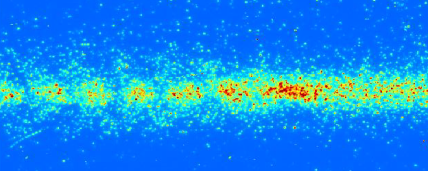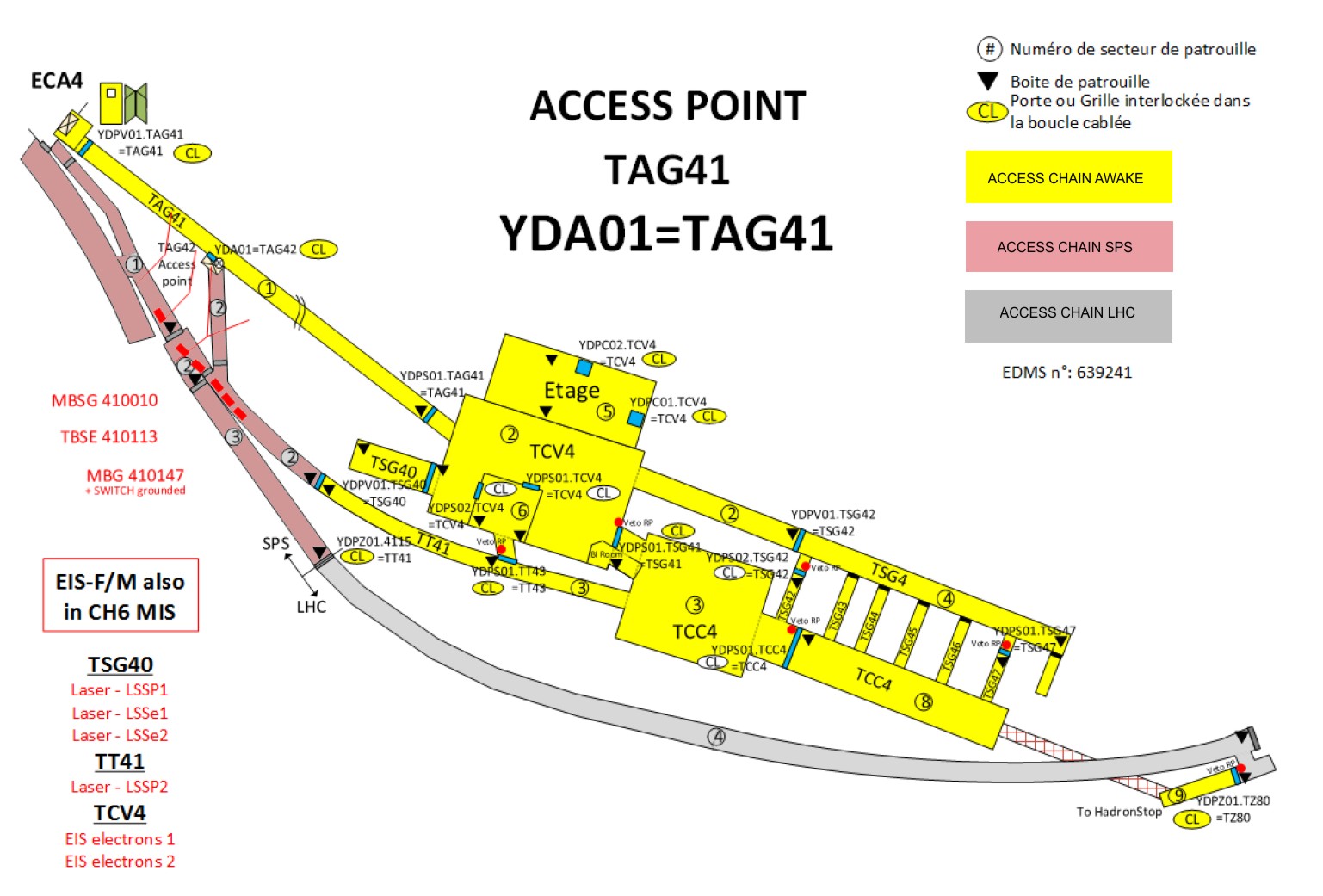AWAKE - A Proton Driven Plasma Wakefield Acceleration Experiment at CERN
Effect of Proton Bunch Parameter Variation on AWAKE
Amplitude enhancement of the self-modulated plasma wakefields
Learn more - General Public
What is plasma wakefield acceleration? How do you accelerate particles? And why do you want to?
AWAKE accelerates electrons using plasma wakefield acceleration, because this new method of acceleration allows for accelerators that are easily hundred times smaller than machines with conventional acceleration methods. Smaller accelerators are less costly and decreasing sizes make accelerators more easily available wherever they are needed, be it in a doctor's office, a university lab or at CERN.
You can compare electron acceleration at AWAKE with wave surfing on Lake Geneva.
The placid lake is disturbed by a boat passing by, displacing the water and leaving waves in its wake. A surfer behind the boat happily catches a wave and is accelerated by the water flow at the wave's crest.

AWAKE does the same, with the difference that:
- our "lake" is a 10m-long Rubidium plasma cell,
- our "boat" are many little boats together, and we call it "drive beam". The drive beam consists of many protons from CERN's SPS accelerator and creates an electrostatic wave in our "lake"
- our "surfers" are electrons that we send to the "lake" and inject exactly at the crest of the wave. We call the electrons "witness beam" and it contains the accelerated particles.
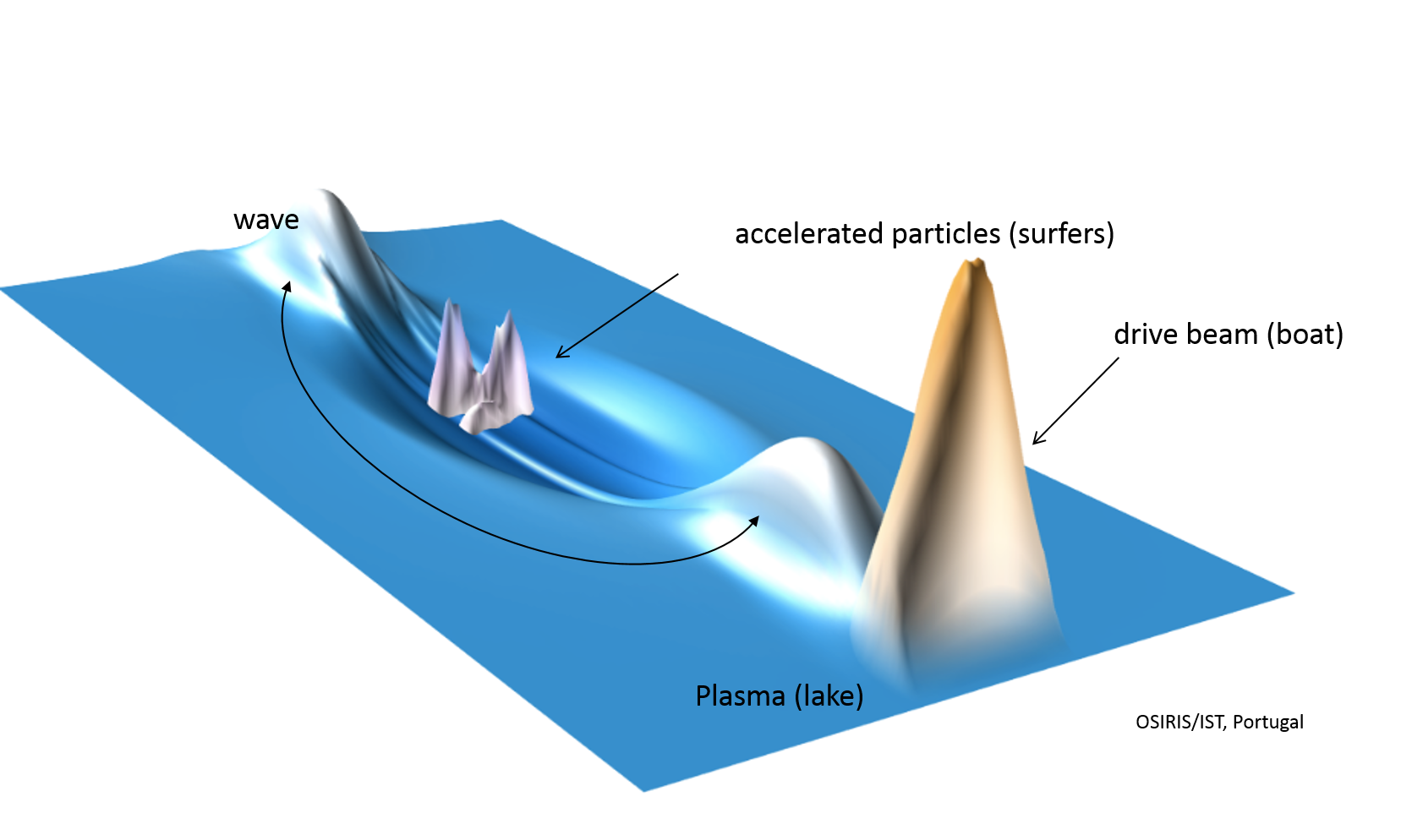
Do you want to learn more about AWAKE's acceleration and surfing equipment?
- Learn more!
- Zach at smbc-comics has drawn a beautiful and funny Plasma Wakefield Acceleration Guide - make sure you also hover over the image to read the alt-text!
- AWAKE participated in CERN's "Nuit des Chercheurs" event on 28/9. The posters below explain plasma, particle acceleration and AWAKE, in French, to the general public. We also showed the AWAKE TEDxCERN video, with French subtitles.
Learn More - Scientists
[text copied from previous AWAKE page - needs much more. could be based on the presentation given to PSI]
[depending on the level/details of the explanation, it can be eitehr (or both if level in between) be a "go deeper" page following the "AWAKE for general public" or the "AWAKE for scientists"]
[intro, recap]
The construction of ever larger and costlier accelerator facilities has its limits, and new technologies are needed to push the energy frontier. Plasma Wakefield (*) acceleration is a rapidly developing field and a promising technology for future high-energy accelerators. The AWAKE project is a proof-of-principle demonstration experiment that will use the energy of CERN's 400GeV proton beam (**) in a plasma wakefield to accelerate electrons to the TeV energy regime.
AWAKE is the world’s first proton-driven plasma wakefield acceleration experiment. Besides demonstrating how protons can be used to generate wakefields, AWAKE will also develop the necessary technologies for long-term, proton-driven plasma acceleration projects.
AWAKE is an international scientific collaboration made up of 18 institutes and 2 associate institutes and involving over 80 engineers and physicists (November 2017).
AWAKE first accelerated electrons in the plasma wakefield of a proton bunch in May 2018, a world's first.
Notes:
(*) A plasma wakefield is a type of wave generated by particles travelling through a plasma. AWAKE sends proton beams through plasma cells to generate these fields. By harnessing wakefields, physicists may be able to produce accelerator gradients hundreds of times higher than those achieved in current radiofrequency cavities. This would allow future colliders to achieve higher energies over shorter distances than is possible today.
(**) AWAKE uses proton beams from the Super Proton Synchrotron (SPS) in the CERN Neutrinos to Gran Sasso (CNGS) facility (see image above for proposed location). These protons are injected into a 10-metre plasma cell to initiate strong wakefields. A second beam – the “witness” electron beam – will then be accelerated by the wakefields, gaining up to several gigavolts of energy.
[showing the basic AWAKE principles]


Learn more - Experts
The Advanced Proton Driven Plasma Wakefield Acceleration Experiment (AWAKE) aims at studying plasma wakefield generation and electron acceleration driven by proton bunches. It is a proof-of-principle R&D experiment at CERN and the world's first proton driven plasma wakefield acceleration experiment. The AWAKE experiment will be installed in the former CNGS facility and uses the 400 GeV/c proton beam bunches from the SPS. The first experiments will focus on the self-modulation instability of the long
(rms ~12 cm) proton bunch in the plasma. These experiments are planned for the
end of 2016. Later, in 2017/2018, low energy (~15 MeV) electrons will be externally injected into the sample wakefields and be accelerated beyond 1 GeV.
AWAKE is a proof-of-concept acceleration experiment with the aim to inform a design for high energy frontier particle accelerators and is currently being built at CERN. The AWAKE experiment is the world's first proton driven plasma wakefield acceleration experiment, which will use a high-energy proton bunch to drive a plasma wakefield for electron beam acceleration. A 400 GeV/c proton beam will be extracted from the CERN Super Proton Synchrotron, SPS, and utilized as a drive beam for wakefields in a 10 m long plasma cell to accelerate electrons with amplitudes up to the GV/m level. In order to drive the plasma wakefields efficiently, the length of the drive bunch has to be on the order of the plasma wavelength λpe, which corresponds to ≈1 mm for the plasma density used in AWAKE (1014–1015 electrons/cm3). The proton beam for AWAKE has a bunch length of sigma_z = 12 cm, therefore the experiment relies on the self-modulation instability (SMI), which modulates the proton driver at the plasma wavelength in the first few meters of plasma. The SMI is a transverse instability that arises from the interplay between transverse components of the plasma wakefields and the wakefields being driven by regions of different bunch densities. The modulation period s is approximately λpe and the modulated bunch resonantly drives the plasma wakefields. The occurrence of the SMI can be detected by characterizing the longitudinal structure of the proton beam when exiting the plasma cell.
Physics behind AWAKE
It is the aim of the AWAKE project at CERN to demonstrate the acceleration of electrons in the wake created by a proton beam passing through plasma. The proton beam will be modulated as a result of the transverse two-stream instability into a series of micro bunches that will then drive strong wakefields. The wakefields will then be used to accelerate electrons with GV/m strength fields. The AWAKE experiment is currently being commissioned and first data taking is expected this year.
What is a plasma
Plasma is one of the four fundamental states of matter, the others being solid, liquid, and gas. A plasma has properties unlike those of the other states. Plasma consist of a gas of positively charged ions and negatively charged electrons. One of the important characteristics of a plasma is the plasma frequency which defines rapid oscillations of the electron density.
Self-Modulation and microbunches
The AWAKE experiment intends to use the existing SPS beam to drive a high amplitude plasma wakefields, which will then accelerate a witness electron beam. The SPS beam is, however, too long to effectively transfer energy to a plasma-wave. The interaction of the proton beam with the plasma (self-modulation) creates a microbunch structure which is consistent with the plasma wavelength. The resulting micro-bunched beam can effectively transfer energy to the plasma wave.
Take a Virtual Tour of AWAKE
AWAKE beamline schematics (no images)
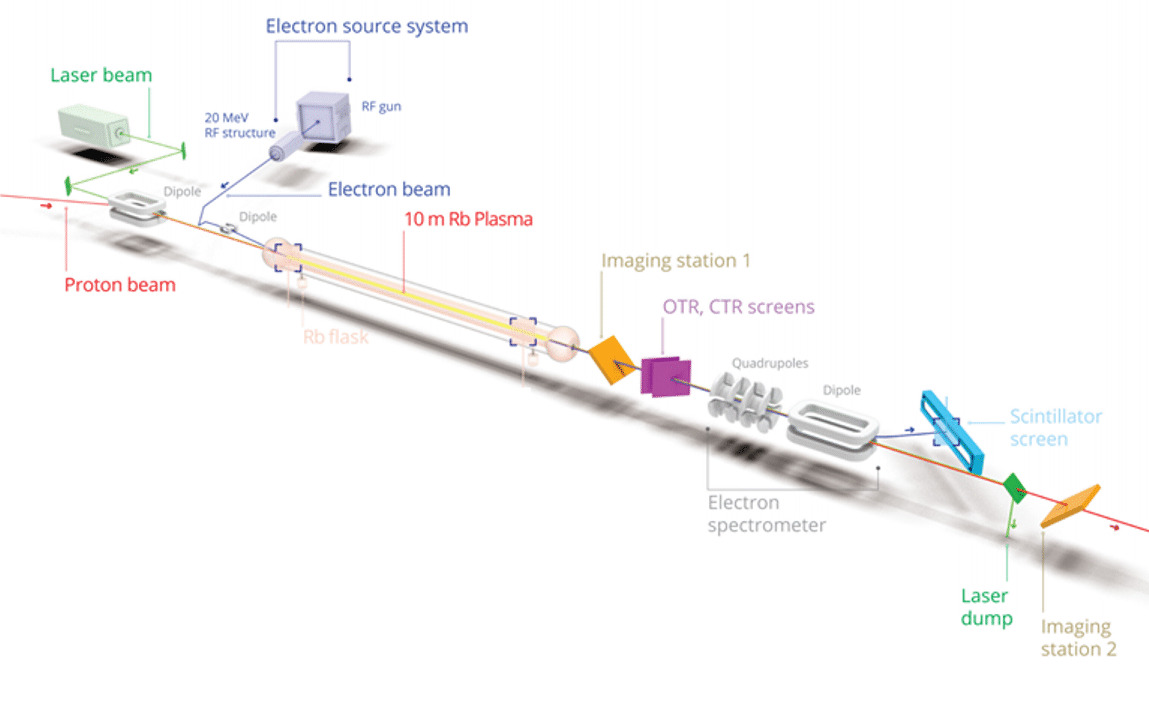
AWAKE beamline schematics (complete)
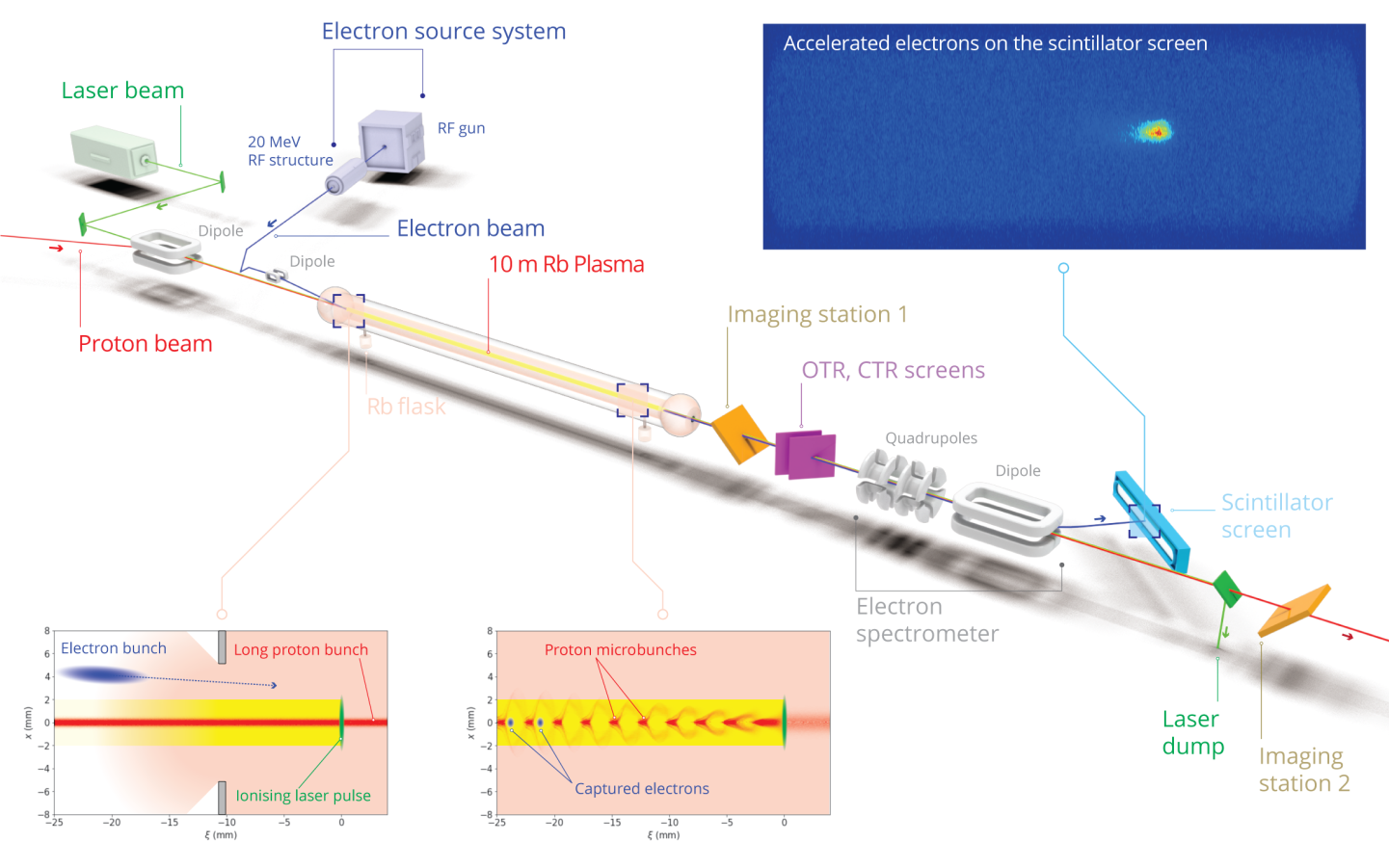
AWAKE cartoon with boat and surfers

Breaking News
CERN release, 27th of July 2023
AWAKE introduces a stronger wave to accelerate particles
Plasma accelerator AWAKE has tested scalability and is all set to begin its second phase of data taking with an upgraded plasma source
https://home.cern/news/news/accelerators/awake-introduces-stronger-wave-accelerate-particles
CERN press release, 29th of August 2018
Update 19th of September: AWAKE's article, referring to the corresponding paper, is available in Nature's September 19th 2018 issue (VOL 561 | NATURE | pages 318-319).
AWAKE achieves first ever acceleration of electrons in a proton-driven plasma wave
In a paper published today in the journal Nature, the AWAKE collaboration at CERN reports the first ever successful acceleration of electrons using a wave generated by protons zipping through a plasma. The acceleration obtained over a given distance is already several times higher than that of conventional technologies currently available for particle accelerators. First proposed in the 1970s, the use of plasma waves (or so called wakefields) has the potential to drastically reduce the size of accelerators in the next several decades.
On 26 May, the AWAKE collaboration successfully accelerated witness-electrons for the first time. Electrons injected into AWAKE at relatively low energies of around 19 MeV (million electronvolts), “rode” the plasma wave, and were accelerated by a factor of around 100, to an energy of almost 2 GeV (billion electronvolts) over a length of 10 metres.
While previous experiments of wakefield acceleration have relied on using electrons or lasers to drive the wake, AWAKE is the first to use protons. “Drive beams of protons penetrate deeper into the plasma than drive beams of electrons and lasers,” said Allen Caldwell, Spokesperson of the AWAKE collaboration. “Therefore, wakefield accelerators relying on protons for their drive beams can accelerate electrons for a greater distance, consequently allowing them to attain higher energies.”
By accelerating electrons to 2 GeV in just 10 metres, AWAKE has demonstrated that it can achieve an average gradient of around 200 MV/m (million volts per metre),” says Technical Coordinator and CERN Project Leader for AWAKE, Edda Gschwendtner. For comparison, the advanced conventional technologies considered for the next generation of electron accelerators promise gradients in the range of 30–100 MV/m. These represent today’s state of the art in particle accelerators for the overall distance over which acceleration can be sustained, on the one hand, and the intensity and quality of accelerated beams, on the other – two important factors required for high-energy physics experiments. The next steps of AWAKE, which aims to achieve 1000 MV/m, include addressing these additional requirements.
Additional information:
Interview with Edda Gschwendtner, CERN Project Leader for AWAKE (2018)
AWAKE video 360 (2018)
Surfing wakefields to create smaller accelerators (2015) by Edda Gschwendtner at TEDxCERN

